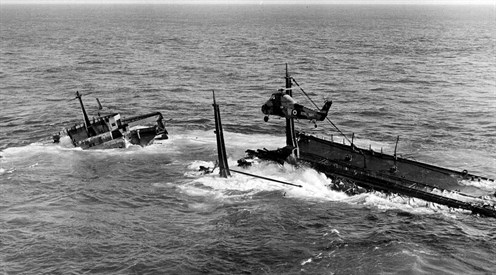By Graham Rhodes
Any one in the services knows, ''never volunteer for anything''. Wives don't know this, ''have a try, just keep it clean'' says she.
As a Clearance Diver in the RN, in 1967 I was part of the Plymouth Command Deep Diving Team.
On the morning of March 18th, the 61,000 ton T/V Torrey Canyon ran aground on Pollard Rock on the Seven Stones Reef off Lands End. Approximately 86,000 barrels of Kuwait Export Crude Oil ran into the English Channel.

The Team were quickly tasked to report on the wreck and whether or not conditions were suitable for diving. Five hours before reaching the vessel a powerful smell of oil was in the air. When I first saw this enormous ship from a distance she looked completely undamaged. She could have been lying peacefully at anchor.
We left the support vessel in a Gemini (inflatable) and approached the lee-side of the wreck. I recall the surface oil was so thick it was hard to establish it's depth. There was a force 4-5 wind and a very strong swell running, although the enormous overwhelming size of the vessel offered a good lee.
We were quickly engulfed by several large waves totally covering us, the boat and the diving gear with thick oil. The fumes in our eyes and noses caused coughing, spluttering and a lot of slithering and swearing! Just to be helpful a helicopter hovered over us, continually spraying us with oil lifted by it's downdraft.
After a lot of messing about, and much more swearing, we decided to pack it in. By now the gear was in such a poor state a paddling pool would have defeated us.
Sadly at this time the only casualty to the incident happened. During attempts to salvage the vessel a heavy explosion occurred in the engine room. The force blew Kapitein H.B. Stal (from the salvage company Wijsmuller) and a crew member of the Praia da Adgra overboard. Kap. Stal died shortly afterwards.
The subsequent bombing, burning and destruction of the vessel is well reported. Once on fire the “powers that be” seemed surprised the tide came in and put the fire out, so they had to do it again! In total over 42 x 1000 lb bombs were used, including what was called “liquefied petroleum jelly” because, of course, HMG denied we had napalm !!??!!
After the destruction of the vessel we returned to the wreck, intending to dive and assess the damage, establishing if all the tanks had been blown. Sea conditions made diving on the wreck still too hazardous, the Government however had a different opinion; a Survey must be carried out. Oh well that's what the extra pay was for.
Weather conditions eventually allowed us onto the wreck, not nice. The damage was awful, 20mm thick steel plates ripped open, visibility underwater very bad, large sections of the ship were constantly moving about, enormous sharp sections came at you from out of the murk and equipment was being fouled.
The noise the ship made was spooky. Removing 18in dia. circular inspection plates , as evidence the tanks were oil free, was difficult, 20 bolts per plate - what a job. Additionally, we were looking for the ordinance that hadn't gone off! Regular return visits were made for the same reasons.
30 years later a delayed reward came my way when my son was completing his Environmental Science Degree.
By then I had a collection of “junk” including underwater photographs, some taken of the Torrey Canyon and accumulated paperwork that had lain in my garage all this time. My son found them, told to keep his mouth shut about his source; they became the center piece of his environmental dissertation.
His tutors were very curious where the photos had come from, especially the ones with “restricted” on the back. Surprised how he knew 10,000 tonnes of detergent had been sprayed to emulsify and disperse the oil, and the detailed information about the substantial long term marine damage this caused.
Combined with other information he had a good result
So it all turned out well in the end, what goes around comes around............sometimes!